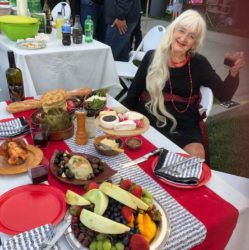Makes enough pastry for 2, 2-crust 8 or 9 inch pies
Bea’s Perfect Pastry
Bea lived in a big, marvelous old house in the Berkeley hills and when I was a kid we visited her often. She was my mentor, my guru, my sole-mate from the time I was ten until I lost her in my thirty’s. I think she was about sixty five when I first met her. Bea had been a political activist all her life. She had been the first woman probation and parole officer in Alameda county, back in the very early twenties. She had marched down Market Street to gain the vote for women; she picketed the House Un-American Activities Committee hearings and the Vietnam war. She had also had the great good fortune to meet a sizable number of literary greats who lived in or had passed through the San Francisco Bay aria including Jack London, George Bernard Shaw, and Henry Miller of ”Tropic of Cancer” and “Tropic of Capricorn” fame. Bea made the best apple pie I have ever eaten and it was, believe it or not, Henry Miller who taught her to make the pastry. The following is that recipe.
- 5 cups of all-purpose flour
- 1 pound (4 sticks or 2 cups) cold butter, margarine, shortening or lard *
- 1 egg
- 1 tablespoon white distilled vinegar
- Cold water
Put the flour into a large bowl. Cut the butter into small pieces and add. Using a wire pastry blender, incorporate the butter into the flour until it is the texture of coarse cornmeal.
Put the flour into a large bowl. Cut the butter into small pieces and add. Using a wire pastry blender, incorporate the butter into the flour until it is the texture of coarse cornmeal. Put the egg and vinegar into a one cup measure and mix well. Add enough cold water to make a total of one cup liquid. Using a table fork, make a well in the center of the flour and butter mixture and pour in the liquid all at once. With the fork, stir round and round until all the dry ingredients have been moistened and gathered into a ball.
Turn out onto a very lightly floured surface and knead very gently, just enough to sort of push all the bits and pieces together. Form into two balls and flatten each into a disk that is about one half inch thick. Wrap in plastic and refrigerate for 30 minutes before using.
Remove from the refrigerator and use for what ever pastry application you wish: pies, turnovers, tarts, etc.
Freezing:
This pastry freezes very well. If you are using it in a recipe that will not require the total amount produced here, you may easy freeze what is left. In fact, I often make the pastry up and freeze it to have on hand when I need to bake a pie.
To freeze, I suggest you cut the total amount produced here into four equal portions. Make each into a ball and then flatten into a disk about one half inch thick. Wrap each in plastic and freeze. Always thaw at room temperature. Never, ever thaw in the microwave.
About Pastry:
You have noticed that many recipes for pies and other pastry goods say to chill before baking and then have you put them into a very hot oven for a few minutes before reducing the heat to around 350° for the remainder of the baking time. This helps insure that the pastry will be flaky. Steam is a very powerful force, after all it can move a locomotive. Your pastry has a very high moisture content. If you get it cold and then put it into a very hot oven, steam is created, and that steam actually blows the pastry apart into flakey little layers.
* My preference is for 1/3 butter and 2/3 lard. Lard gives the best texture and butter the best flavor.
Vegetarians and Vegans use non-dairy butter or shortening substitute

